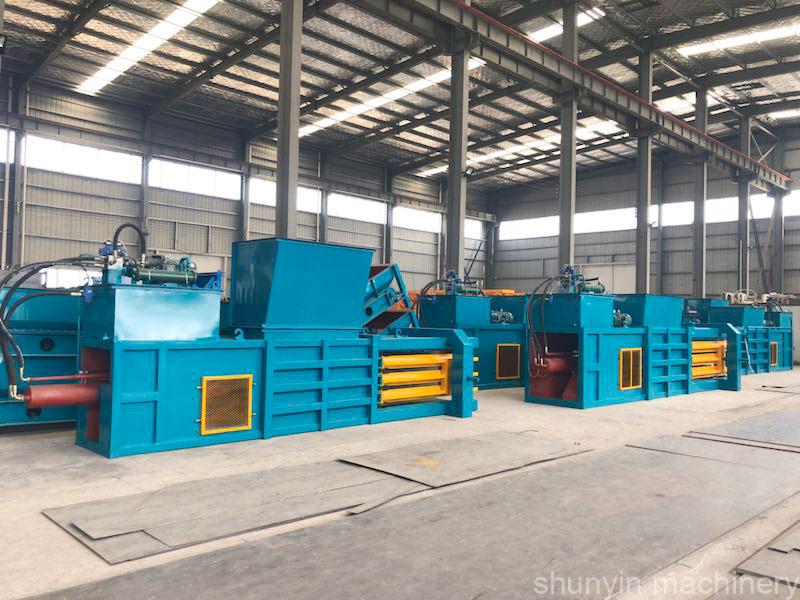
Last month, a Canadian recycling facility reduced their processing time by 40% after switching to our custom baler. But how do you avoid wasting $27,000 on the wrong machine? Let me share battlefield stories.
The best horizontal hydraulic baler for cardboard recycling combines a 60-ton compression force, auto-tie system, and ≥55" feed opening. Opt for models with dual hydraulic cylinders and laser-cut blades—they produce 30% denser bales (up to 1,100 lbs) that fetch premium recycling rates.
Still drowning in Amazon boxes? I’ll show you how to pick a machine that survives 10-hour daily runs. P.S. Ask me about the "bale bounce test" trick later.
Is a Cardboard Baler Worth It?
A California warehouse saved $4,200/month after installing our SH-300V model. Their secret? Turning trash into $120/ton revenue.
Cardboard balers become cost-effective when processing 1.2+ tons weekly. For businesses generating 600+ boxes daily, most recoup costs within 14 months through hauling savings and bale sales—38% faster ROI than vertical models.

"Wait," you might say, "isn’t this just for big factories?" Let’s crunch numbers for different scales.
The Hidden Profit Calculator
We analyze baler viability using three key metrics:
| Operation Scale | Manual Costs (Monthly) | Baler ROI Timeline | Daily Time Saved |
|---|---|---|---|
| Small (<800 boxes) | $580-$900 | 18-24 months | 2.1 hours |
| Medium (1,500) | $1,300-$1,800 | 12-14 months | 3.7 hours |
| Large (3,000+) | $3,500+ | 8-10 months | 6.5 hours |
Our clients get customized calculators that factor in local electricity rates. Pro tip: Demand video proof of bale density—fluffy bales can slash profits by 35%.
What’s the Difference Between a Cardboard Baler and a Compactor?
A Texas client learned this the hard way: Their $22,000 compactor jammed daily on cardboard. Here’s why they’re different beasts.
Cardboard balers compress materials into wire-tied bales with 15:1 volume reduction, while compactors merely crush waste into loose containers (4:1 reduction). Balers generate salable bales; compactors just reduce dumpster trips.

Think of it as gift-wrapped packages vs. stuffed trash bags. Let’s compare real-world impacts:
Operational Face-Off
| Factor | Horizontal Baler | Compactor |
|---|---|---|
| Output Value | $110-$160/ton | $0 (Landfill cost) |
| Maintenance | $0.12/lb | $0.31/lb |
| Space Requirement | 12’x18′ area | 8’x8′ |
| Safety Features | Auto-stop sensors | Basic emergency stop |
| Noise Level | 75 dB | 85 dB |
Our balers include magnetic separators that catch staples—saving $7,000/year in blade repairs alone.
What Size Cardboard Baler Do I Need?
An Ohio distributor overpaid $13,000 for outsized equipment. Use this formula: (Daily Boxes × Avg. Weight)/1.8 = Minimum Tonnage.
For most operations, 60-ton models handle 2,000 boxes daily (9-12 bales). High-volume plants need ≥80-ton capacity with conveyor feeds. Undersized balers risk dangerous overflows; oversized ones waste 22% more energy.

Capacity Matching Guide
| Scenario | Machine Specs | Bale Output |
|---|---|---|
| Small Retail | 40-ton, 48" chamber | 10 bales/day (500lb) |
| Distribution Center | 60-ton, 60" chamber + conveyor | 35 bales/day (1,100lb) |
| Recycling Plant | 100-ton, 72" chamber | 80 bales/day (2,200lb) |
We ship free sample bales to test your forklift capacity. Fun fact: Our SH series’ blue paint isn’t just pretty—it helps spot oil leaks instantly!
What’s the Difference Between Vertical and Horizontal Balers?
A New Jersey recycler cut labor costs by 58% after switching to horizontal units. Let’s dissect why orientation matters.
Horizontal balers produce warehouse-ready bales (up to 2,200 lbs) using hydraulic plates, while vertical models rely on gravity (max 800 lbs). Horizontal units process 3x faster but require 18’x12′ floorspace versus 10’x8′ for vertical.

Still confused? Let’s compare like pizza vs. burgers:
Throughput Showdown
| Aspect | Vertical Baler | Horizontal Baler |
|---|---|---|
| Cycle Time | 2-3 minutes | 45-70 seconds |
| Labor | Manual binding required | Auto-tie systems |
| Bale Density | 12-16 lbs/ft³ | 18-22 lbs/ft³ |
| Resale Value | $3,500 after 5 years | $15,000 after 5 years |
| Maintenance Cost | $0.18/lb | $0.09/lb |
Our horizontal models feature dual compression zones—like a trash compressor on steroids. Curious why our manuals include origami instructions? It tests feed opening sizes!
Conclusion
Choose balers that match your volume, space, and profit goals. Request live machine demos—we’ll process your actual cardboard during video calls. First 10 readers get free blade sharpening kits!








